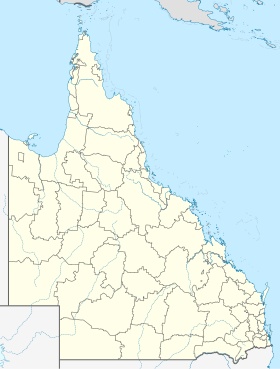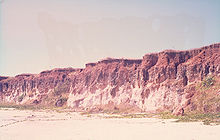Weipa
| Weipa | |||||||
|---|---|---|---|---|---|---|---|
 Weipa |
|||||||
|
|||||||
|
|||||||
|
|||||||
|
|||||||
|
|
|||||||
Weipa (pronounced: wiːpə ) is the largest city on the Gulf of Carpentaria and on the Cape York Peninsula . The 2016 census counted 3,899 residents. The city owes its size to the enormous bauxite deposits along the coast. Mainly bauxite and cattle are exported via the port.
geography
Weipa is located a little south of Duyfken Point , a cape that is now known to be the first point in Australia that a European came into contact with. The Dutch explorer Willem Jansz first saw the Australian coast from his ship Duyfken here in 1606 . That was 164 years before Lieutenant James Cook landed on the east coast of Australia.
climate
| Weipa | ||||||||||||||||||||||||||||||||||||
|---|---|---|---|---|---|---|---|---|---|---|---|---|---|---|---|---|---|---|---|---|---|---|---|---|---|---|---|---|---|---|---|---|---|---|---|---|
| Climate diagram | ||||||||||||||||||||||||||||||||||||
| ||||||||||||||||||||||||||||||||||||
|
Average monthly temperatures and rainfall for Weipa
Source: missing
|
|||||||||||||||||||||||||||||||||||||||||||||||||||||||||||||||||||||||||||||||||||||||||||||||||||||||||
history
Weipa was founded in 1898 as an outpost of a Presbyterian mission station.
In 1911, Queensland introduced very restrictive legislation that established a protector as legal guardian for all Aboriginal and half-blood children under the age of 21. The Protector had the right to send any of his protégés to any reservation (or to ban him from it) and to have him locked up for 14 days if, in his opinion, he was guilty of a breach of duty, gross insubordination or a call to disobedience . These laws also allowed the police to lock Aborigines in reservations to "keep them from decaying". This power was also granted to Comalco in 1957 to justify the expulsion of the Aborigines from Weipa.
In 1932, due to a malaria epidemic , the community had to be relocated from Jessica Point (today: Napranum ) to its current location. The old location was about twelve kilometers south of today's settlement. At that time most of the residents were from the Awingthim tribe , but other tribes and clans were later brought in from Old Mapoon (at Cape York, where the Aborigines were evicted and their settlements burned down on November 15, 1963) and other settlements.
In 1955 a geologist, Henry Evans (1912–1990) discovered that the red cliffs in the indigenous reserve, which had been mentioned by early Dutch researchers and also by Matthew Flinders , were mainly enormous bauxite deposits - i.e. aluminum ore - and contained a small amount of tungsten ore .
The Comalco Act 1957 lifted the status of a reservation and secured the mining company 5,760 km² of land on the west coast of the Cape York Peninsula and 5,135 km² on its east coast - also Aboriginal land, but not a reserve. The mining of bauxite began in 1960. In 1966 the mission settlement became a state settlement, with Comalco relocating the entire settlement several times. The mining company then built a new town for their workers on the other side of the bay.
Bauxite mining
Today's city was mainly built by Comalco (today: Rio Tinto Alcan ), a large aluminum company that tried to ship bauxite to Japan as early as 1962. A railway line was built from the mine in Andoom to the heap at the harbor at Lorim Point . This bauxite mine has been the largest of its kind in the world since 2010.
Facilities
Weipa has a public library, visitor center, swimming pool, cinema, bowling green , golf club and mining museum. There is also a shopping center with a general store, bakery, café and sports shop.
literature
- Ron and Vivian Moon: Cape York: An Adventurer's Guide . 9th edition. Moon Adventure Publications, Pearcedale VIC 2003, ISBN 0-9578766-4-5 .
- David R. Moore: Islanders and Aborigines at Cape York: An ethnographic reconstruction based on the 1848–1850 'Rattlesnake' Journals of OW Brierly and information he obtained from Barbara Thompson . Australian Institute of Aboriginal Studies. Canberra 1979, ISBN 0-85575-082-0 . (USA edition: ISBN 0-391-00948-6 )
- Jan Roberts: Massacres to Mining: The Colonization of Aboriginal Australia . Dove Communications, Blackburn VIC 1981. Revised Australian edition. Previous edition: CIMRA and War on Want, London 1978, ISBN 0-85924-171-8 .
- Connell Wagner: Cape York Peninsula Resource Analysis . Premier's Department, Cairns 1989, ISBN 0-7242-7009-6 .
- WE Roth: The Queensland Aborigines . 3 volumes 1897. (Reprint: Facsimile edition, Hesperian Press, Victoria Park WA 1984, ISBN 0-85905-054-8 )
- Michelle Ryan, Colin Burwell (Eds.): Wildlife of Tropical North Queensland: Cooktown to Mackay . 3 volumes. Queensland Museum, Brisbane 2000, ISBN 0-85905-045-9 .
- Vera Scarth-Johnson: National Treasures: Flowering plants of Cooktown and Northern Australia . Vera Scarth-Johnson Gallery Association, Cooktown QLD 2000, ISBN 0-646-39726-5 .
- Peter Sutton (Ed.): Languages of Cape York: Papers presented to a Symposium organized by the Australian Institute of Aboriginal Studies . Australian Institute of Aboriginal Studies, Canberra 1976, ISBN 0-85575-046-4 .
- Lennie Wallace: Cape York Peninsula: A History of Unlauded Heroes 1845-2003. Central Queensland University Press, Rockhampton QLD 2003, ISBN 1-876780-43-6 .
- Jo Wynter, Jo and John Hill: Cape York Peninsula: Pathways to Community Economic Development . The Final Report of The Community Economic Development Projects Cook Shire, Cook Shire Council 1991.
Web links
- Roderick Eime: A Cape to Adventure . Description of a trip to Cape York in an all-terrain vehicle
- Website of the Cooktown Shire
- Photo collection by Wolfgang Sievers from the "Presbyterian Mission Station Weipa" 1957
- Queensland Places: Weipa . University of Queensland
Individual evidence
- ↑ a b Penguin Books Australia: Explore Queensland . Penguin Books Australia, Camberwell VIC 2002, ISBN 0-14-300015-2 , p. 60.
- ↑ a b Australian Bureau of Statistics : Weipa ( English ) In: 2016 Census QuickStats . June 27, 2017. Retrieved April 15, 2020.
- ^ Macquarie Dictionary . 4th edition. (2005). The Macquarie Library. Melbourne, ISBN 1-876429-14-3 .
- ↑ Jan Roberts: Massacres to Mining: The Colonization of Aboriginal Australia . Dove Communications (1981), ISBN 0-85924-171-8 , p. 34.
- ↑ Jan Roberts: Massacres to Mining: The Colonization of Aboriginal Australia . Dove Communications (1981), ISBN 0-85924-171-8 , pp. 115-116.
- ↑ Jan Roberts: Massacres to Mining: The Colonization of Aboriginal Australia . Dove Communications (1981), ISBN 0-85924-171-8 , p. 97.
- ^ John L. Buckland: The Heavy-duty Industrial Railway at Weipa . Australian Railway Historical Society Bulletin. June 1975, pp. 143-148.
- ↑ Weipa . Center for the Government of Queensland. Retrieved January 17, 2011.

